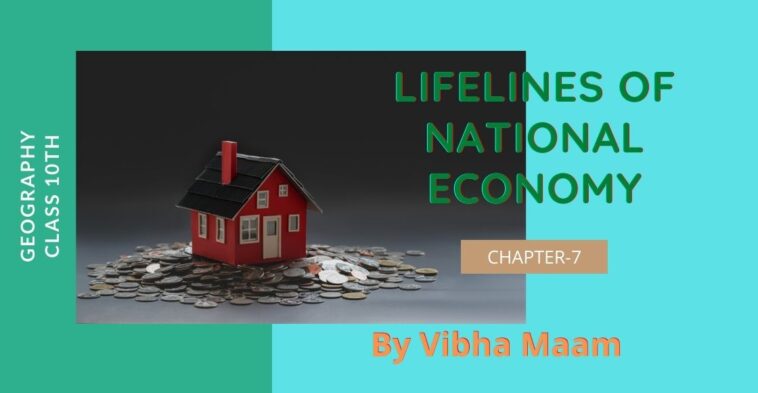Checkout handpicked notes of NCERT class 10th Geography Chapter 7 Lifelines of National Economy notes by Vibha Madam and don’t forget to share your valuable comments in the comment below to motivate our author.
Lifelines of National Economy Notes by Vibha Maam
Development of any country depends upon the production of goods and services as well as transportation. Goods and Services can be moved from supply location to demand location with the help of efficient and fast moving transport. Transportation, communication and trade are complementary to each other.
Trade and transport has been expanded along with the development in Science and technology.
Railways, Airways, waterways, newspapers, radio, television, cinema, telephones and internet etc. have been contributing to its socio-economic progress in many ways. Expansion of trade and commerce from local to international made possible with the help of transportation and communication.
Means of Transport
Land Transport – Roadways, railways ,pipelines
Water Transport – inland waterways, overseas waterways
Air Transport – Domestic airways and international airways
Roadways
India has one of the largest road networks in the world.
Importance of roadways
- It can be built any terrains
- Construction cost is much lower compare to railway lines
- Provides door to door service
- More suitable for short distances
- Economical and accessible for all
- Provide a link between other modes of transport
Classification of Roads
Golden Quadrilateral Super Highways
Six lane highways that connect major cities and ports of the country. These Highways projects are being implemented by the National Highway Authority of India (NHAI).
National Highways
These roads connect major cities of two or more states. These roads are laid and maintained by the Central Public Works Department (CPWD). the historical Sher Shah Suri Marg is called National Highway no.1 between Delhi and Amritsar.
State Highways
These roads connecting the state capital with different district headquarters. These roads are constructed and maintained by the State Public Works Department ( PWD)
District Roads
These roads connecting the district headquarters with other places of the district. These roads are maintained by the Zilla Parishad.
Rural Roads
These roads connect villages with towns. These roads receive special impetus under the ‘Pradhan Mantri Gramin Sadak Yojana’ which are maintained by Gram Panchayat.
Border Roads
These are constructed in border areas and have strategically important. border roads organisation, a government of India undertaking constructs and maintains these roads.
Railways
The Indian railway is the largest public sector undertaking of India.
Railways are the principal mode of transportation for freight and passengers in India.
Difficulties and problems faced by Railways
- Costly in construction
- Difficult to lay railway lines on the Sandy, swampy and hilly region
- Lack of economic opportunities in a sparse population
- Without ticket travelling
- Damaging of railway property
- Unnecessary chain pulling
Pipelines
Pipelines transport network is a new arrival on the transportation map of India.
Pipeline transport is used for transporting water, crude oil, petroleum products and natural gas.
These are very useful in mountainous regions.
Waterways
waterways are the cheapest mode of transport. They are most suitable for carrying heavy and bulky goods .India has five major National waterways.it is a fuel- efficient and eco-friendly mode of transport.
Major Seaports
- With a long coastline of 7,516.6 km, India is dotted with 12 Major ports and 200 medium and minor ports. Kandla, Mumbai, Kolkata are major ports.
- Kandla in Gujarat was the first port developed soon after independence to ease the load of Mumbai port. This is a tidal port .
- Mumbai is the biggest port in India with a spacious natural and well- sheltered harbour.
- Marmagoa port of Goa is a premier iron ore exporting port of the country .
- Kochi is located at the entrance of a Lagoon with the natural harbour in Kerala. It is called the ‘Queen of Arabian sea’.
- Tuticorin port is located in Tamilnadu. This port has a natural harbour and rich hinterland.
- Chennai is one of the oldest artificial ports of the country. It is the second biggest port of the country after Mumbai .
- Visakhapatnam is the deepest landlocked and well- protected port located in Andhra Pradesh.
- Kolkata is an inland riverine port. Haldia port was developed as a subsidiary port, in order to relieve pressure on the Kolkata port.
Airways
Airways is the fastest mode of transport. In India, the air transport was nationalised in 1953.
On the operational side Indian airlines, private scheduled airlines and non- scheduled operators provide domestic air services. Air India provides International air services. It is an expensive mode of transport and unaffordable for the poor.
Communication
Communication means exchange of ideas, images, messages, emotions, either written or oral form from one place to another.
Mass Communication
The means of communication which provides entertainment and creates awareness among the people on a large scale are known as mass communication.
Personal Communication
- It refers to communication between two parties.
- Television, radio ,internet ,films, press, etc. are the major means of communication .
- The Indian postal network is the largest in the world.
- Cards and envelopes are considered first class mail.
- Books, packets, registered newspapers, and periodicals are considered second class mail.
- To facilitate quick delivery of mail in big towns and cities, six mail channels have been introduced recently .They are called Rajdhani channel, Business channel, Bulk mail channel , Green channel ,Metro channel, and Periodical channel.
- India has one of the largest telecom networks in Asia.
- Doordarshan is one of the largest terrestrial networks in the world .
International Trade
The exchange of goods among people, states and countries is referred to as trade.
Trade between two countries is called international trade. International trade is considered the economic barometer for a country.
Local trade is carried in cities, towns and villages.
State level trade is carried between two or more States.
Export and import are the components of trade .
The balance of trade of a country is the difference between the export and import.
- When the value of exports is more than the value of imports, it is called a Favourable Balance of Trade.
- And if the value of imports is more than the value of exports, it is called an Unfavourable Balance of Trade.
In the last few years India has emerged as a software giant at the international level and it is earning a large amount of foreign exchange through the export of information technology.
Tourism as a Trade
Tourism in India has grown substantially over the last three decades. More than 15 million people are directly engaged in the tourism industry.
Tourism promotes national integration, provides support to local handicrafts and cultural pursuits. foreign tourists visit India for heritage tourism, eco-tourism, adventure tourism, cultural tourism, medical tourism and business tourism.
Don’t forget to comment in the comment section below to appreciate and motivate our author by sharing this notes with your friends you can also Contact us for any query or if you are interested in writing with us.
Use Canva for amazing images.
Stay tuned for more amazing stories, poems & articles like this.
For sponsor any article or your article you can mail us with your logo ready and details.











Excellent notes mam
Fantastic notes mam
Nice